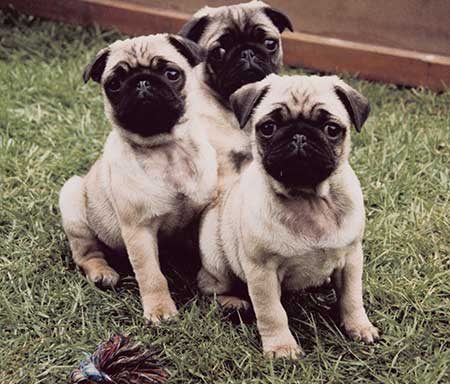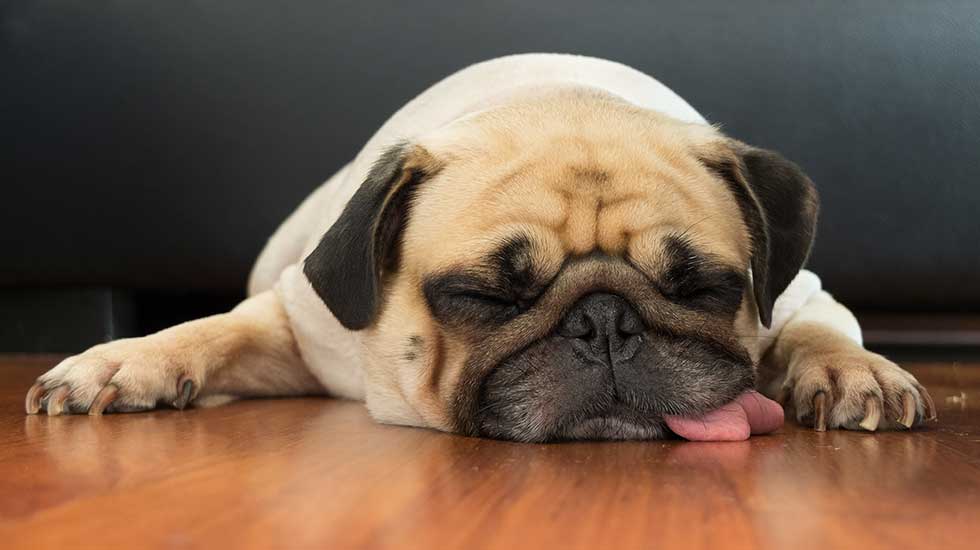Overview
Pugs are: Even-tempered, charming, mischievous, loving, and adaptable; The largest breed in the AKC Toy Group—portable but sturdy; Originally from Asia, though long associated with The Netherlands; A very popular pet the world over; Easy to groom, but—despite its short coat— a dog that sheds.
Pugs love: Kids; Adults who are still kids at heart; Romping; Napping; Snacking.
Pugs hate: Being alone.
Feeding
Pugs are among dogkind’s top gourmands. If the AKC gave awards for eating, the Pug would have a lock on the CHX (Chow Hound Excellent) title. Owners of all breeds should carefully monitor their dog’s diet, but it’s an especially important consideration for Pugs.
“A good quality dry dog food, moistened with warm water, is generally all they need,” say the experts at the Pug Dog Club of America. They recommend that Pug pups under 6 months old be fed three times day. After 6 months and up to the 1-year mark, cut feedings down to twice a day. An adult Pug should be getting one full portion of food once a day, or two half potions in the morning and evening.
Now, here’s the hard part: No table scraps. It’s hard because … well, just look at that poor little guy under the table, with his big, soft eyes pleading for just one little french fry. And then another. And another. And “Please, please, just one more, I’m soooo hungry.” Before you know it, you’ve turned your Pug into a pig.
Yes, it’s difficult to refuse that little scam artist at your feet. But for his own good, you’ve got to gird yourself and say no. Pugs are prone to obesity and, just as with humans, carrying too much weight can lead to illness, injury, and even death.
A show-quality Pug will weigh between 14 and 18 pounds. If yours is considerably heavier, consult with your vet about putting him on a diet.

Health
Pugs are relatively healthy dogs, capable of living to 15 or older when well cared for. Aside from health issues all dog owners must consider, Pugs have some special considerations:
A Pug’s large eyes, with no muzzle to protect them, can be easily injured by thorns or other sharp objects.
As flat-faced, short-coated indoor companions, they don’t do well outdoors in extreme temperatures, hot or cold.
The ears and the wrinkle over the nose must be cleaned regularly, to avoid infections and other nasty stuff.
Exercise
Bred for centuries to be devoted laptop companions, Pugs are not exactly known for their athletic prowess. Many pug owners can brag about their dogs’ skill on the agility course or other sporting venue, but most Pugs do best with two or three brisk walks a day. If your Pug has put on a few extra pounds, don’t try to sweat it off of him all at once with a crash course of vigorous exercise: Their short muzzles make it difficult to breathe when overexerted, especially in warm weather. Also, Pugs are generally lousy swimmers, so be careful around water.

Training
As companion-bred toys, Pugs are eager to please you. And, as born aristocrats, they are natural gentlemen. But all dogs must learn basic obedience—a well-executed “stay,” “sit,” or “come” might save your dog’s life someday. Curious and intelligent, Pugs will train well with firm direction. But patience is certainly a virtue when training these pint-sized comedians. A longtime breed fancier says, “You must be warned, they are clowns at heart.”
Here’s an in-depth look at a common health problem: “How to Keep Your Pug From Overheating.”
Feeding is a major consideration for Pug owners. If you have a Pug puppy, check out the free e-book below.
Hit the mother lode of Pug info at Pug Dog Club of America


